

 The South African
The South African
by Colonel D.E. Peddle
'The production of this gun must be considered one of the most remarkable events in the history of beleaguered garrisons . . . . Truly a feat of which any mechanical establishment might be proud.' Thus the 'Times History of the War in South Africa, 1899-1902'(iv, 560).
In considering the validity of this statement account should be taken of the events leading to the gun's manufacture, some of the difficulties encountered and how these were overcome, plus something about the gun itself and what it achieved. The story really begins before the outbreak of the Anglo-Boer War.
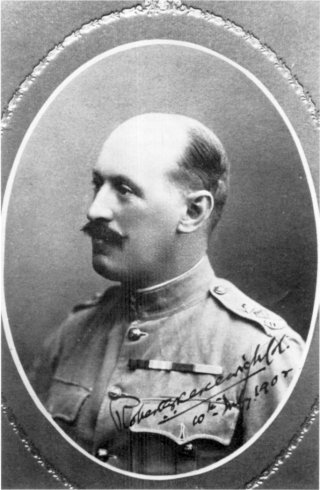
On 13 September 1899, just four weeks before war was declared, Lt-Col R.G. Kekewich, commanding the 1st Battalion The Loyal (North Lancashire) Regiment, arrived in Kimberley to assess the military situation there and to advise the new General Officer Commanding British Troops in South Africa (Lt-Gen Sir F.W.E.F. Forestier-Walker) as to what steps should be taken for the town's defence in the event of war between Great Britain and the Republics of the Transvaal and the Orange Free State. The adjoining municipalities of Kimberley and Beaconsfield (for convenience in this article both are regarded as one town and referred to as Kimberley) lie about 8 kilometres west of the Free State border and 72 kilometres south of the Transvaal. It would have taken a matter of hours only for Boer forces to reach the town after a declaration of war. A scheme for Kimberley's defence had been drawn up in 1896 when, amongst other things, a large quantity of rifles, and ammunition and an few Maxim machine guns had been purchased privately and stored in the town, and these were still in Kimberley on Kekewich's arrival. In 1898, and again in June 1899, Lt-Col J.K. Trotter, Royal Artillery, had been sent to Kimberley by Lt-Gen Butler, Forestier-Walker's predecessor, to review and revise the defence scheme, his plan being to defend only Kimberley itself, excluding Beaconsfield, and to hold Wesselton Mine about two kilometres from the Free State border (some old maps show this as 'Premier Mine'). After a thorough reconnaissance and consultations with the local authorities, Kekewich decided to include both Beaconsfield and the outlying Kimberley suburb of Kenilworth within a defended perimeter some 22 kilometres in length, as he felt this was the minimum he would have to hold in order to protect the town's 50 000 inhabitants and four of the richest diamond mines in the world. He too considered it essential to hold Wesselton Mine as an isolated strongpoint since it would be the only adequate source of drinkable water should the normal supply from the Vaal River, 35 kilometres to the north, be cut - as indeed happened. What Kekewich found available locally for the defence of the town was little short of alarming, a situation aggravated by obvious military preparations already taking place across the Transvaal border, together with confirmed evidence of similar activities in the Free State, just across the way.
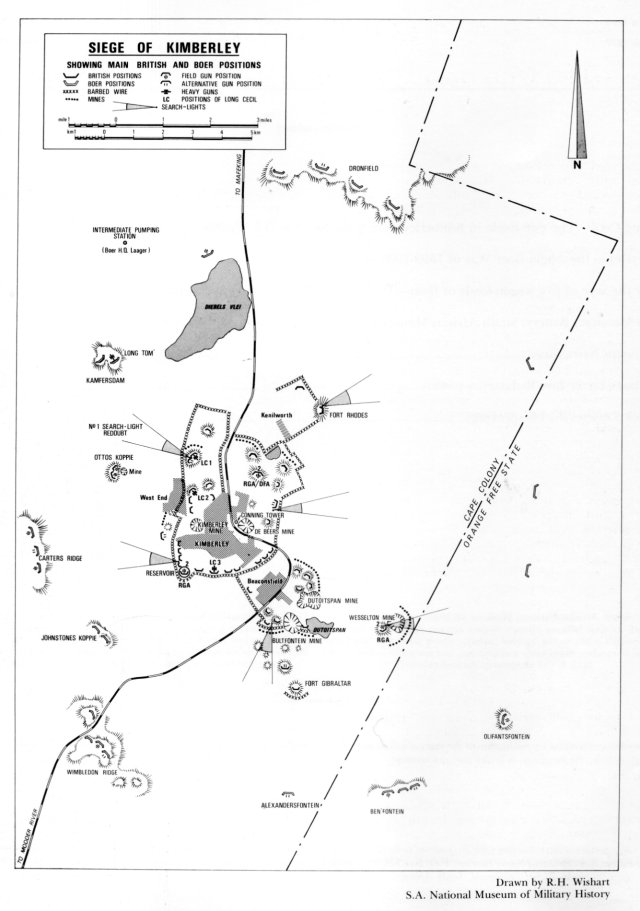
There were no British troops in Kimberley at that stage and, according to Kekewich's official report on the siege, local volunteer units (Diamond Fields Artillery, Diamond Fields Horse, and the Kimberley Regiment) could muster only 540 officers and men between them with six rifled muzzle-loading 2. 5-inch mountain guns fitted to 'Kaffraria' field carriages (some accounts give a slightly higher total of volunteers available at this stage). The RML 2. 5-inch guns, firing a 3.34 kg shrapnel shell, had a range of 3 000 metres and could reach 3 600 metres when firing ring shell, but at Kimberley's high summer temperatures and altitude of 1 220 metres it was later found that targets could be engaged with ring shell at ranges almost up to 4 600 metres.
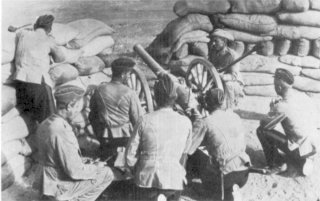
The guns had arrived in Kimberley the preceding July to replace some worn-out old RML 7-pounders, but Maj T.J. May and his 90 officers and men had neither exercised with, nor fired, their new guns as they had neither horses to move them, nor ammunition to use! Kekewich discovered too that he could not place these units on standby since they could not be called out without proclamation of a state of emergency by the Cape Parliament, sitting 1 041 kilometres away in Cape Town and refusing either to recognize the seriousness of the local situation, or to do anything which might offend the Free State Government. The obvious solution was to get British regular troops moved into Kimberley as soon as possible, and Kekewich wired Lt-Gen Forestier-Walker asking for the immediate despatch of field artillery, infantry, engineers, and services and medical personnel to Kimberley.
Between 20 and 26 September, 23 Company Royal Garrison Artillery, four companies and a mounted infantry section of The Loyals, one section from the 7th Field Company Royal Engineers, and a dozen officers and men of the Army Service Corps and Royal Army Medical Corps arrived in the town, a total of about 596 all ranks. These were the only reinforcements Kekewich ever received, and were all that could be spared, since the total British garrison in the Cape Colony at that time amounted to only two RGA companies in the forts at Cape Town, three and a half battalions of infantry, one RE field company, and some services and medical units. There was no field artillery other than the horseless volunteer battery of Cape Field Artillery equipped with six Mark I BL 15-pounders and subject to the same call-up restrictions as the Diamond Fields Artillery.(1) It is worth noting perhaps that the total British garrison in South Africa at the end of September 1899 amounted to 11 978 all ranks with three field artillery batteries and one mountain battery, and that two-thirds of this force, including all four batteries, was in Natal.
Together with 14 Coy RGA, 23 Coy was one of the two normal peacetime garrison-artillery companies at the Cape and had a strength of 4 officers and 90 other ranks, being commanded by Maj (later local Lt-Col) G.D. Chamier, RA. It was to be equipped on arrival in Kimberley with six RML 2.5-inch mountain guns on their mountain carriages (these were the type of guns made famous by Kipling's ballad 'Screw Guns'), which were being railed up from King William's Town where they had been stored against possible use in the troubled and mountainous areas of the Eastern Cape frontier. Four of these guns arrived shortly after 23 Coy reached Kimberley, the remaining two arrived on 12 October, the day after war had been declared. Accustomed to firing BL 9.2-inch and 6-inch coastal defence guns, the comments of 23 Coy's Gunners on taking over their diminutive muzzle-loaders firing black powder charges must have been worth hearing! One suspects the blow was softened somewhat by the prospect of engaging targets more attractive than those normally provided during practices seawards. With the arrival of these reinforcements, Kekewich's total force in Kimberley the day after war was declared amounted to 1 220 British regulars and local volunteers with twelve 2.5-inch guns, the local volunteer units having been called out on 5 October and having been joined by some 80 recruits.
Two days after war broke out, members of the para-military Cape Police started riding into Kimberley from abandoned outlying police posts, bringing with them two obsolete RML 7-pounder Mark IV guns and some ammunition. These were mounted on 'Colonial' field carriages and had a maximum range of about 2 700 metres and fired 3.46 kg studded common shell.(2) Eventually, Cape Police in the town totalled 478 all ranks and formed part of the garrison throughout the siege, taking an active part in the defence. Their arrival, plus recruiting for existing volunteer units and the hurried raising of new 'hostilities only' units, soon brought the garrison's strength up to about 4 600 officers and men, but more than half of these were completely untrained. An amusing authentic account describes how, during the actual assault on Carter's Ridge by part of the garrison on 25 November 1899, a member of the newly-raised Kimberley Light Horse enquired of his officer how he should attach his bayonet to his rifle 'as he could never get it quite right'! With this force Kekewich kept the Boers at arm's length throughout the four-mouth siege, the garrison doing all the attacking.
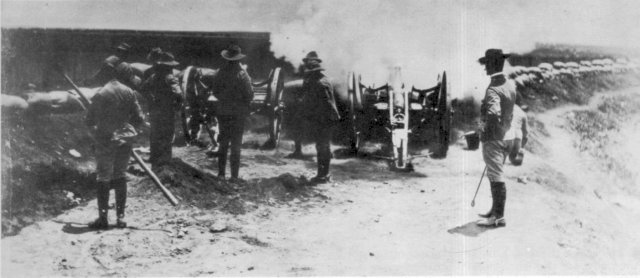
The strength of the investing Boer force varied between 3 000 and 5 000 men supported by nine field guns. Eight of these were 75mm Krupp guns with a 5 500-metre range when 6.12 kg segment shell was fired and a range of about 3200 metres when 5 kg shrapnel shell was used. The ninth gun was an old RML 9-pounder of 8 cwt with a range of about 3 200 metres. This gun was later captured by the garrison and is still in Kimberley. In keeping with their normal practice, the Boers sited their guns singly around the town, most of them being just beyond shrapnel range of the 2.5s emplaced in the Kimberley defences, some being even beyond range of ring shell. In any event, the little 3 kg shells of the garrison's guns were ineffective against the earthbanked dry-stone walling used in nearly all the Boer positions around the town. The Boer gunners could thus shell Kimberley without fear of effective counter-bombardment, and this they proceeded to do from about the end of October onwards, displaying a fine disregard for target selection by scattering their shells liberally throughout the residential and business areas of the town. From recorded shelling reports the Boers fired about 8 500 rounds into Kimberley during the siege causing little serious damage to property and remarkably little loss of life (only nine civilians and one soldier were killed by shell-fire), but causing a good deal of annoyance.
News that Lord Methuen and the 1st Division had left Orange River Station on 21 November, on their way to relieve Kimberley, plus further news that he had won three battles and reached Modder River Station in a week, made the inhabitants of Kimberley feel that relief could not be far off and that Boer shelling would have to be endured for at most a few more days. Hopes were dashed on 11 December by Methuen's shattering defeat at Magersfontein, only 22 kilometres away, and by messages from him to the effect that it would be some time before his advance could be resumed and enquiring whether the town could hold out. Boer shelling continued.
Nobody really knows who first mooted the idea of making a gun in Kimberhey which could outrange the Boer artillery, but credit is usually given to George Labram, an American engineer in the town. He had come to South Africa in 1893 to erect a new crusher plant for one of the Kimberhey mines, staying on to become Chief Engineer to De Beers Consolidated Mines Ltd, the company owning all the Kimberley diamond mines and which was under the chairmanship of Cecil Rhodes. In August 1899 Labram resigned his post with De Beers to take up another in the gold-mining town of Johannesburg but, for some reason, was still in Kimberley when war broke out. A good mechanical engineer with a fertile brain, Labram not only designed and made 'Long Cecil', for which he is perhaps best remembered, but during the first three weeks of the siege he designed and constructed a plant for the bulk refrigeration of perishable foodstuffs - essential with shade temperatures averaging about 31 degrees C. He had also installed an emergency fresh-water supply system, which became the town's sole supply (apart from one or two wells) for the whole siege, and had given much practical assistance and advice to the Royal Engineers in laying out controlled minefields around the town, and with the design and actual construction of the defences. Then, as the garrison's artillery had expended nearly a third of its ammunition by the end of November, Labram turned part of De Beers' workshops over to making shells, charges, and fuzes for the 2.5-inch guns.(3) Prior to all this he had perfected a method (still in use) for the extraction of diamonds from the crushed rock of the mines. His greatest triumph perhaps was turning the workshops into a gun factory as well, never before having had anything to do with gun-making.
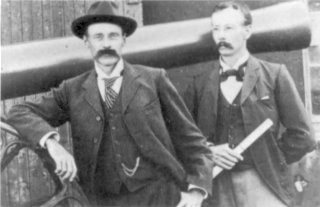
Labram had noticed a billet of steel, 3 metres in length, ordered originally as shafting for one of the workshop machines, which was lying in the workshop yard. As it had a diameter of almost 28 cm it occurred to him that a fairly large calibre gun might be made from it. There were no books on gun-making in Kimberley but he remembered attending a lecture given some years previously by Sir William Anderson on the engineering aspects of the subject. With recollections of this, Labram and the De Beers' Chief Draughtsman (Edward Goffe) sought out all they could find on guns and their construction. There was not much available, only the few paragraphs on gunnery in the Encyclopaedia Britannica, some articles on guns in an old engineering journal, a War Office 'Treatise on Ammunition', and a gunnery textbook owned by an enthusiastic officer of the Diamond Fields Artillery. Having read all these and discussed the subject with Lt-Col Chamier, who it seems was somewhat lukewarm about the whole idea, Labram decided it would be worthwhile attempting to make a gun which could reply more effectively to the Boer Artillery than the garrison's little mountain guns. On Christmas Night 1899, he put the suggestion to Rhodes and was given an immediate go-ahead. Work on the gun started next day.
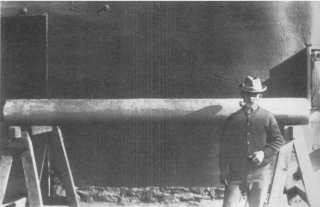
Rough preliminary calculations indicated that to make a gun with a desired range of a little more than 7 600 metres would require one with a calibre of approximately 100 mm firing a 12.7 kg shell and using a 2.26 kg black powder charge. To allow sufficient air space round the charge a chamber of 107.9 mm diameter with a length of about 304 mm, thus achieving a capacity of about 2 785 cc, would be needed. The steel billet was large enough to permit this. Labram estimated that a chamber pressure of about 339.77 MPa (22 tons per square inch) would be reasonable to expect and his next problem was to ascertain whether the steel would withstand this, considering that the billet had not been intended as gun steel and probably had too low a carbon content. Further calculations indicated that some form of strengthening would be required and that shrunk-on rings, or hoops, should meet the case. (It was learnt after the siege that the prescribed minimum tensile breaking strain for forged gun steel at that time was 525.1 MPa (34 tons per square inch) and that the 'Long Cecil' steel had a breaking strain of between 416.99 MPa and 463.33 MPa!).

Labram had read about the De Bange system of obturation and, as the manufacture of cartridge cases was out of the question, he decided to follow the standard British field artillery practice of the time by making a BL gun since the manufacture of obturator pads would present no special difficulty.(4) Any thought of a buffer and recuperator system was likewise dropped, partly for technical reasons and partly because nobody really knew very much about this type of recoil arrangement. It was felt in any case that the final weight of gun and carriage, together with the use of drag shoes, would keep the gun steady on firing, and this proved to be the case although wheel brakes were also fitted later on.
These points settled, the first task was to rough-turn the steel billet to an external diameter of 26.67 cm at the breech, tapering to 22.06 cm at the muzzle, allowing for muzzle swell, and leaving a 3 mm shoulder all round to take the thrust of the trunnion ring. This done, the task of drilling out the bore commenced, a calibre of 104 mm (4.1 inches) having been decided upon. Using an adjoining lathe as well, a 38 mm hole was bored right through, using a twist drill, then this hole was first enlarged to a 76.2 mm diameter and then to 100 mm, the difference between this and the final calibre being taken up during rifling. Of interest is the fact that the lathe is still in use today having, in the interim, been used for turning gun barrels during World War II as well! Working 24 hours a day, closely supervised by William Berry, the workshop foreman, whose pride and joy the gun became, this task was completed in just under a week.
Meantime, under Labram's supervision, Goffe had been busy making the drawings and blueprints for the sights, breech screw, strengthening hoops, carriage, and shells, not to mention the tools for rifling the bore, which had to be specially designed and made. As each drawing was completed so work on that item commenced at once. A great deal of experimentation by trial and error took place as problems arose, since neither Labram nor any of his foremen had had any experience of gunshop practice. Fortunately, some of the artisans had worked previously in either the Royal Gun Factory at Woolwich, or else at Elswick, and came forward with ideas and suggestions.
The first items completed were the strengthening hoops and the trunnion ring. Two rows of hoops were required, the inner row having nine hoops plus the trunnion ring and the outer row four. These hoops were made from 15.2 cm x 6.35 cm Low Moor iron bars cut to length and bent into a circle with the ends welded together, and then machined to the exact size required. The inner hoops had an internal diameter (less shrinkage) of 26cm, whereas the outer hoops had an internal diameter of about 36.2 cm when made. The trunnion ring at first presented a major problem as it was considered impossible, with the equipment available, to make a satisfactory weld in so heavy a piece of metal. The leading blacksmith came up with a solution, however, by taking a length of 15.2 cm x 15.2 cm iron bar through which he drilled a small hole from one side to the other. This hole was then gradually enlarged by successive heats until it was of almost the correct size to slip over the gun tube. It was then machined to the required internal diameter and the trunnions themselves were turned. By this time boring of the gun tube had been completed.
In order to fit the strengthening hoops the tube, or barrel, was slung, breech-end upwards, from a derrick, the ends were plugged, and a constant circulation of cold water was arranged inside the bore. Meanwhile, the strengthening hoops were being heated over a wood fire. As soon as they had expanded sufficiently, the hoops were slipped one by one over the end of the tube, the trunnion ring going on first and resting against the shoulder left when the billet was first machined. As each hoop was put on, it was clamped into position whilst cooling and shrinking, the hoop below it being kept cool by a stream of cold water from a garden hose. Once the seven hoops in rear of the trunnion ring were in place, the tube was reversed in the derrick and the two front hoops were fitted. The tube was then taken back to the machine shop and the outside of the hoops were turned to form a seating for the four outer hoops which were then fitted in a similar manner. Final external machining of the gun was then done.
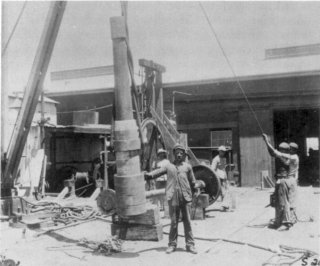
A good deal of thought had gone into the type of rifling to be cut and how it was to be done, Labram eventually deciding on a polygroove plain section type having 32 grooves with a righthand twist, each groove being 6.35 mm wide and 1.58 mm deep.(5) To lessen the strain on the gun, and on the shell's driving band when firing, the rifling had a twist of 1 in 100 at the commencement of rifling increasing to 1 in 32 at the muzzle, the final 58cm being uniform at 1 in 32. After overcoming a good many problems in designing and making the tools needed, and meeting difficulties encountered when cutting of the rifling first commenced, the job was completed in a little less than 48 hours of continuous work. The chamber was then reamed out to a diameter of 10.79 cm and the threads cut to take the breech screw. Originally it had been planned to make an interrupted thread breech screw which could be removed completely after a one-sixth turn, no breech carrier being envisaged. Practical problems involved in cutting and smoothing the plain sections in the breech and on the breech screw itself, plus the additional time it would take (estimated at two days), led finally to the making of a continuous-thread breech screw which could be screwed right out and removed by hand, a slower loading rate being acceptable. The mushroom head and spindle was a solid piece of mild steel, there being no axial vent as the gun was to be fired by means of a Mark III friction tube inserted in a copper-lined radial vent drilled through the strengthening hoops into the chamber. As will be seen, these firing arrangements were to cause serious problems and had to be altered once the gun was in service. The obturator pad was, to all intents and purposes, a standard service pattern.
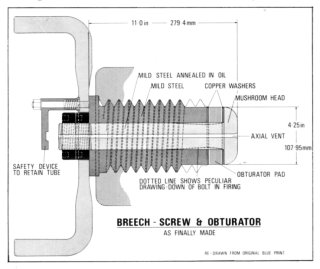
The sights were similar to those in general field artillery use at the time, consisting of a blade foresight fitted to the right trunnion and a tangent hindsight copied from those used on the 2.5-inch guns. When fitted in its brass clamp on the right of the breech opening, the tangent sight had an inclination of two degrees to the right to compensate for drift and, to everyone's delight when the gun was tested, this turned out to be almost exactly correct. When made, the sight bar of the tangent sight was not graduated, pending calibration, but the crosshead was fitted with a deflection scale. A clinometer plane was cut just forward of the radial vent and, in practice, it seems that both the layer and the No.1 of the gun preferred laying for elevation by clinometer and used the tangent sight for line only. There was no top traverse, all traversing being done by means of two handspikes fitted into sockets on either side of the trail eye. Elevating arrangements were simple, consisting of a long screw passing through a transom nut fixed between the trail legs and attached to a hinged lug bolted on to the underside of the piece below the breech. The screw was rotated by means of a spoked handwheel and the gun could be elevated between 0 and +26degrees.
The carriage had been completed by the time the gun itself was finished and consisted of four 6.35 mm steel plates cut to the shape of carriage and trail and riveted together in pairs, 57 mm apart. Gun metal castings, also riveted to the plates, served as axle and trunnion bearings. The two pairs of plates were then bolted together, 43.8 cm apart, using shouldered bolts. The wheels were the only parts not made, having been taken off a disused mobile steam engine. A roller was fitted underneath the trail closing plate to assist in running the gun up into the emplacements which had been prepared for it. When completed, the centre of the trunnions was 1.52 metres above ground and 12.7 cm behind a vertical line through the centre of the axle, the trail eye being 2.89 metres behind the same point. The wheels were 1.52 metres apart, centre to centre. A limber was also made for the gun, being of a standard pattern and possessing no special features.
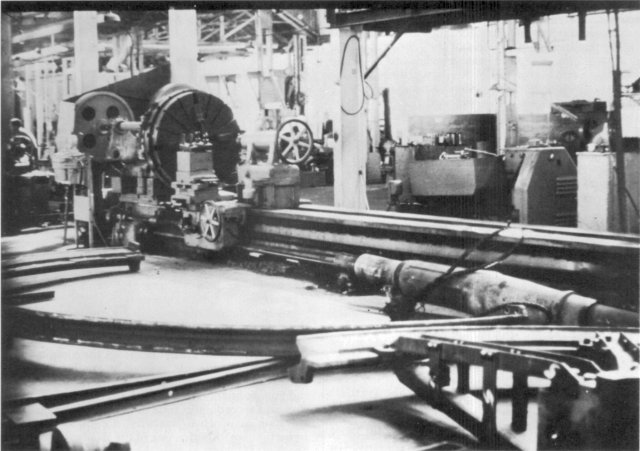
After 24 days continuous work, much of it under shellfire (one or two direct hits had been scored on the workshops and there seem to have been several near-misses), gun and carriage were completed on 18 January 1900. By this time too the ammunition had also been made, the only components not manufactured in Kimberley being the powder, friction tubes, and the detonators for the fuzes. The large-grain black powder used for shell fillings and charges consisted of sticks of gunpowder 50.8 mm in length and 11 mm in diameter. This stock of powder had been in Kimberley for more than ten years and, thanks to good storage, was still in perfect condition. An adequate supply of mealed powder was also available for use in the fuzes. As already mentioned, some experience had been gained in ammunition manufacture since shells, fuzes and charges for the 2.5-inch guns had been made locally since the previous November.
Ring and common 2 crh(6) shells were made for 'Long Cecil', each weighing 12.7 kg unfilled and having an overall length of 33cm. The shells were of cast steel, the rings in the ring shell being of cast iron and, for ease of manufacture, the shells were cast with a hole in the nose and base, the latter then being sealed with a screwed-in brass plug. Every shell was steam-tested at a pressure of 861.84 kPa (125 lb per sq in) so as to reveal any flaws in casting (this was probably done as result of a premature burst with one of the locally made 2.5-inch shells). The shells were then lacquered internally, turned to a 102 mm external gauge, and a groove was cut for the driving band according to a method adopted in England as recently as April 1899, i.e., by having the sides undercut instead of straight. The ribs in the groove were the standard straight British type, cut away at intervals, waved ribs being introduced in British ammunition in June 1901. A 19 mm wide copper driving band was then fitted. This was a narrow Vavasseur type, locally designed, with three cannelures cut round its circumference to take up the surplus copper dragged back by the rifling lands, and was an improvement on British field-gun driving bands of the period.The hole left in the nose of the shell was then threaded internally to take the fuze, the shell was filled with a 0.454 kg gunpowder bursting charge and plugged (fuzes were fitted at the gun position). As proof of origin, and no doubt adding a collector's value amongst Boer souvenir hunters, each shell had 'DE BEERS' and a diamond shape cast into the base, whilst some even had 'WITH COMPTS CJR' (Rhodes's initials) stamped on the body near the driving band! The 2.2 kg propellant charges were sewn into wool-serge bags made by a local draper and taped with silk.
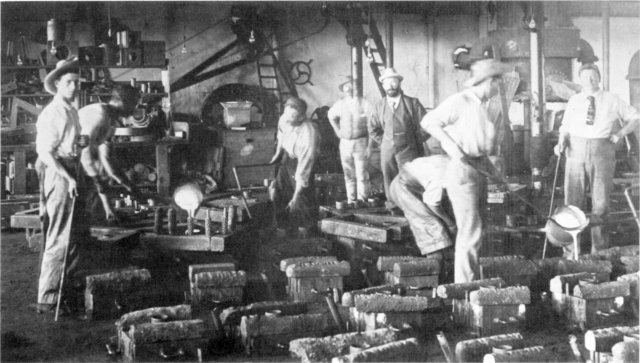
The percussion nose fuze, designed by Labram, was identical to those already in use with the locally made 2.5-inch shells and was of simple design. Although not a graze fuze in the true sense, it did not require the shell to hit the ground at a steep angle of descent in order to function since there was no striker which had to be driven in. As will be seen from the accompanying section drawing, the gun-metal fuze body was tapered and threaded externally and had a channel bored centrally through it for almost the whole of its length, the undrilled portion being pierced by a fire hole. The upper end of the channel was threaded internally to take a brass detonator plug, the detonator itself being a shotgun-cartridge cap. Fitting inside the channel and held against the fire hole by two lead safety pins, each having a shearing stress of 18.14 kg, was a steel plunger, or pellet, which served as both striker and magazine. The lower cylindrical portion of the plunger was hollowed out from the base and filled with mealed powder, thus forming the magazine, and the open end was sealed with a muslin disc. The conical upper portion, which acted as the striker, had a flash channel drilled through it from the apex to the magazine, and fitting round the striker, between the shoulders of the plunger and the detonator plug, was a steel detent spring having a 1.36 kg tension. On impact, the plunger's inertia sheared the two lead safety pins and it flew forward, compressing the detent spring, to strike the detonator. The resultant flash passed down the flash channel setting off the powder in the magazine which, in turn, ignited the shell filling, there being no primer in the shell itself. It was an efficient fuze and there appear to be no recorded reports of 'blinds' due to malfunctioning. This is more than can be said of standard British direct action fuzes of the period, and for many years afterwards, as these frequently failed to function when the angle of impact was too acute for the striker to be driven in, or caused it to bend and jam.
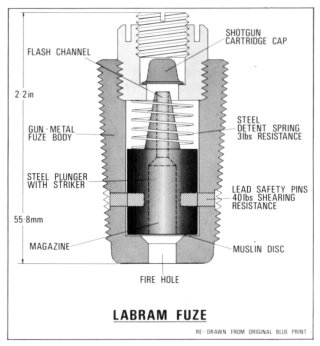
On Friday, 19 January, 1900, the gun, nicknamed 'Long Cecil' in honour of Cecil Rhodes, was taken for testing and calibration to one of the three emplacements already prepared for it. Rhodes, who had taken a great interest in the gun and its manufacture, was present, along with a number of local dignitaries and senior officers of the garrison. He invited Lt-Col Chamier, as the senior Gunner, to fire the first round. The story goes that Chamier refused on the grounds that, as a member of the Royal Regiment, he was permitted to fire only such guns as had been officially approved by the War Office and that 'Long Cecil' definitely did not fall within this category! Rhodes, so the story continues, then told Chamier to remove himself to a safe distance and sent his pony and trap to fetch Mrs Pickering, wife of the Secretary to the De Beers Company. On her arrival, Rhodes handed her the end of the firing lanyard, inviting her to pull it. This she duly did, with some trepidation, and fired the first round from 'Long Cecil' - of this latter part of the story there is no doubt. The round landed and burst in the middle of a hitherto safe and quiet Boer laager at the Intermediate Pumping Station some 7 200 metres away, causing considerable alarm and dismay according to Boer letters written at the time, some of which were later intercepted by the British.
Firing a further fifteen rounds (Rhodes himself fired several) the gun was thoroughly tested and data recorded for the compilation of a range table. Although no detailed account of the procedure followed appears to exist, it seems that a 'range and accuracy trial', somewhat modified and adapted, was carried out. Mr C.D. Lucas, one of the De Beers Company's surveyors wrote that he recorded 'data for several shots taken at different elevations' and also that the 'wind pressure and direction, atmospheric pressure, weight and class of powder and recoil of the gun were carefully noted.' As the garrison's Royal Artillery officers were either not asked to assist, or preferred to have nothing to do with the whole business, Lucas undertook the compilation of the range table himself, assisted by another De Beers' surveyor, J.P. Cornwall. Lucas set up his theodolite at the gun position, observing the bearing to each fall of shot and recording its time of flight and the quadrant elevation at which it was fired. Cornwall positioned himself at Fort Rhodes, one of the Kimberley redoubts about 6 000 metres away to the right and at an angle of about 100 degrees to the line of fire, and cross-observed each shell burst. From these observations it was a simple matter to calculate the exact range to each shell burst and thus arrive at a mean range for all the rounds fired at each quadrant elevation (usually a group of about ten rounds is fired at each of three different quadrant elevations during a range and accuracy trial but, judging by the ammunition expenditure that morning, it seems that only five could have been fired at each elevation). From data thus recorded it is possible to compute the quadrant elevations for the intervening ranges and thus compile the range table. Lucas then went away to do his sums, admitting later that he could not get the gunnery textbook formulae to work out and so invented his own! A copy of Lucas's range table as compiled and used with the gun, together with a table comparing 'Long Cecil's' main characteristics with those of similar British guns then in service, are given at the end of this article.
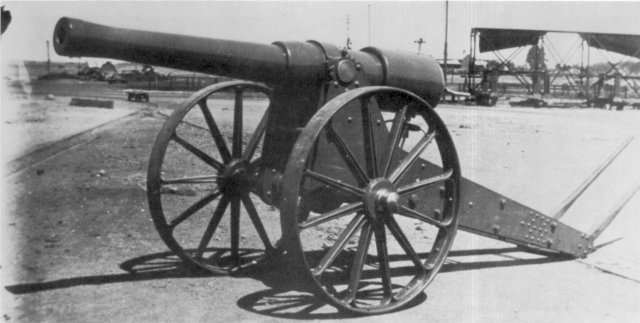
The gun behaved well during the test firing and was then taken back to the workshops for a thorough technical examination, no flaws being found. Some adjustments were, however, made to the elevating arrangements, a better foresight was fitted, and the threads on the breech screw were flattened slightly as it tended to set back on firing and become difficult to open. In spite of allegedly refusing to fire the gun, Chamier obviously took some interest in it as he wrote in his own hand opposite the entries for 19 January, in the 'Remarks' column of the ammunition return for that day: 'Tried "Long Cecil". Results good but Mr Labram WILL use too heavy a charge.' Chamier was later proved correct on this point.
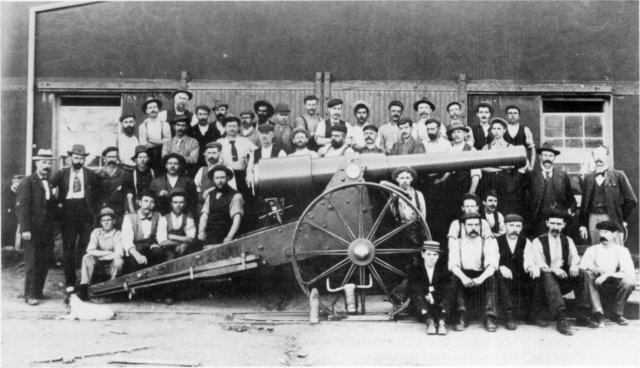
On 21 January 'Long Cecil' was handed over to the Diamond Fields Artillery who provided a 10-man detachment under Sgt James Wheaton, an ex-member of the Royal Navy who had quite understandably included a number of former bluejackets in his detachment. The following day the gun and its detachment were attached to the RGA section commanded by Lt H.M. Close, RA, and joined them at No 1 Searchlight Redoubt. The next day, 23 January 'Long Cecil' fired its first rounds in anger, expending 18 rounds that day and 57 on the following day. Filled with enthusiasm no doubt, possibly encouraged by Labram, and hoping to get a bit more range out of their new weapon, the detachment loaded a 2.72 instead of a 2.26 kg charge into a cold gun on the morning of 29 January and, according to Edward Goffe, the first round of the day was 'productive of an extra loud and peculiar report, and the idea that something had gone wrong was general.' Judging by some of the diaries kept in Kimberley during the siege, the 'extra loud and peculiar report' was heard all over town and more people than Goffe and the gun detachment were convinced that something was wrong!
A look at the gun revealed that the outer strengthening hoop containing the radial vent had cracked. The gun was sent down to the workshops where the furnace was fired so that the rearmost outer strengthening hoop could be heated, expanded and slipped off thus releasing the damaged one as well. Whilst this was being done work started on making a new hoop. When the two outer hoops had been removed it was discovered that the two inner hoops on either side of the radial vent had also cracked and these had to be removed as well and new ones made. Careful examination of the chamber revealed no internal or external cracks or damage, but it was noted that the internal diameter of the chamber at the centre had increased by 0.79 mm, there being no measurable increase in external diameter. At this stage the gun had fired 93 rounds and subsequent measurements during the remainder of the gun's service revealed no further expansion - had Labram but realised it he had stumbled on the principle of autofrettaging gun barrels!(7) There seemed to be no apparent cause for the cracked hoops until somebody noticed that there were powder stains on the undersides of the hoops in the vicinity of the radial vent. It then became obvious that gas had forced its way past the outside of the copper tube lining the radial vent and, with the increased volume of gas resulting from the higher charge, this had cracked the hoops by direct pressure. The radial vent was condemned at once and the hole was plugged and sealed. An axial vent was then drilled through the mushroom head and spindle, tests first being carried out to ensure that the flash from the friction tubes in use would carry this additional distance. The new strengthening hoops were shrunk on and a safety device was fitted to the back of the breech screw to prevent the friction tube from being blown out to the rear on firing.
These repairs took about two days to complete and the gun was then returned to its detachment. It fired one round and the mushroom-head spindle broke. A complete spare breech screw and vent axial were at hand and were fitted to the gun. The second spindle also broke after one round. As may be imagined there was a great deal of concern and headscratching as a result. Then one of the fitters let out that when he had worked previously at Woolwich he had heard of a similar thing happening, when six or seven vent axials had broken in as many rounds, and the problem had been solved by annealing them in oil. In near-desperation this was tried. It worked successfully but, as a safety precaution, several spare vent axials were made and kept handy with the gun. After about another fifty rounds it was noticed that there was an inexplicable drawing down, or thinning, of the spindle just in rear of the mushroom-head itself. For safety reasons a new vent axial was fitted. This happened twice, until the charge was later reduced. In a discussion of this problem, when Goffe's paper on the making of 'Long Cecil' was read to the Institution of Mechanical Engineers in London in June 1900, a Mr H.F. Donaldson of Woolwich suggested that the fracturing and thinning of the spindle was possibly due to the 'sharp angle' at the base of the mushroom-head and that if this had been more generously curved there might have been no problem, even without annealing.
These problems overcome, the gun continued in action, engaging Boer positions to the north and north-west of the town. Then, on 9 February, a major tragedy occurred. To trace its cause one must go back to the early days of the siege.
As far back as 20 November 1899 Gen J.H. de la Rey, then in the Kimberley area, had suggested to President Kruger that one of the four 155 mm Schneider siege guns in the forts around Pretoria should be sent south to shell Kimberley into submission. (These were the four famous 'Long Toms' usually referred to as Creusot guns). De la Rey's suggestion was turned down as three of these guns were already in Natal, whilst the fourth was in action shelling the town of Mafeking. The appearance of 'Long Cecil' gave new meaning to De la Rey's idea as its shelling of hitherto safe laagers had forced the Boers to move their headquarters and administrative areas out of range and, in addition, many of their forward positions hitherto out of British gun range were now receiving some unpleasant attention. Gen S.P. du Toit, commanding the Transvaal forces at Kimberley, renewed De la Rey's request. By this time the 'Long Tom' situation had altered somewhat. On 5 December 1899, a British raiding party from Ladysmith had badly damaged one of the Long Toms shelling the town. The gun was sent to Pretoria for repair and was again serviceable by the end of January 1900. Kruger authorized its despatch to the Kimberley area where Gen P.A. Cronje, sitting at Magersfontein, had also asked for one of these guns to shell Lord Methuen's steadily growing camp at Modder River Station, and to reply to the 4.7-inch guns, manned bv the Naval Brigade and 15 Coy RGA, which were shelling his defences almost daily. (Cronje had even gone so far as to blast a gunpit into one of the rocky hillocks at Magersfontein for his hoped-for 'Long Tom' - it is still to be seen). Backed by Col de Villebois-Mareuil's recommendation, Du Toit's request won the day and the gun arrived at Kamfersdam, a little more than 6 kilometres north-west of Kimberley, on 6 February and was promptly dragged to the top of a mine dump and into a prepared emplacement. (De Villebois-Mareuil was a famous French officer serving as a soldier of fortune and military adviser to the Boers. He was killed in action two months later).
Following on increased shelling by all the Boer guns around Kimberley, the 'Long Tom' opened fire on the town on 7 February, its 43.5 kg segment and shrapnel shells causing a good deal of damage and near-panic amongst the townspeople who had become almost accustomed to the generally ineffective shelling by the lighter Boer field guns. At about 6 p.m. on 9 February the last round fired by the 'Long Tom' that day hit the Grand Hotel in the centre of Kimberley, bursting in the second floor room where Labram was changing prior to going to dinner with Rhodes. Labram was killed instantly. The following evening, to the intense disgust of the Kimberley people, the 'Long Tom' gunners shelled the start of Labram's funeral procession at the Kimberley Hospital and then shelled the Gladstone Cemetery (visible from the gun's position) during the actual burial service. Two days later, on 11 February, over 3 000 women and children were sent underground for safety in the Kimberley and De Beers' mines, and there they remained for the rest of the siege.
The day after Labram was killed Chamier at last had his way and his remark written on the ammunition return for 10 February reads:-'"Long Cecil" - on poor Labram's death I ordered all the charges to be broken up and made into 4 lb charges. The gun did not break down again.' Between 10 and 15 February, when Kimberley was relieved, 'Long Cecil' fired a further 107 trouble-free rounds, its reduced maximum range of about 5 900 metres still enabling it to engage its usual targets. Although there is ample evidence of the fact that 'Long Cecil' frequently shelled Kamfersdam, where the Boer 155 mm gun was (a difficult target as this gun was dug in on the crest of a high, steep mine dump), there seems to be no record of the Boer gun ever engaging 'Long Cecil' in an effort to put it out of action. This appears surprising as the latter's existence was one of the reasons for the 'Long Tom' being sent to Kimberley, but it is equally true that the Boer artillery devoted remarkably little time and ammunition to shelling the Kimberley defences, bombarding the town instead. On its last day in action, 'Long Cecil' bade farewell to 'Long Tom' with six rounds before the Boer gun disappeared, and there is no record of what finally happened to this particular gun.
A look at the original handwritten copy of the Total No. of Rounds fired in Kimberley from 24-10-99 to 16-2-00 has proved interesting (the first artillery engagement took place on 24 October and the last rounds were fired on 16 February in support of Gen French's abortive operations to the north of the town). The document is a day-to-day record of ammunition expenditure by 23 Coy RGA, the Diamond Fields Artillery battery, and 'Long Cecil', giving also the targets engaged and the ranges to them. In all, the garrison's Gunners fired a total of 2 281 rounds during the four-month siege and of these a considerable number had been made in Kimberley, including all those fired by 'Long Cecil'. As mentioned earlier, the Boers fired about 8 500 rounds into the town during the same period. Of the 2 281 rounds the six guns of the Diamond Fields Artillerv, which had been used mainly as a mobile field battery during the siege, accounted for 1 033 rounds, their highest expenditure on any one day being 112 rounds fired in support of the Carter's Ridge attack on 25 November 1899.
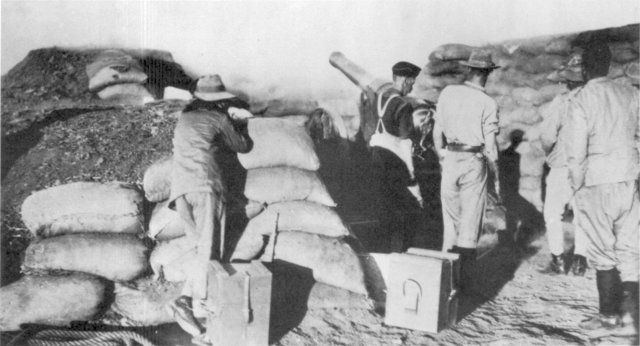
23 Coy RCA fired a total of 988 rounds, its expenditure being reflected by sections since its guns had been deployed in pairs in the forts throughout the siege. As far as can be established, the RCA section which fired the most rounds was that commanded by Lt H.M. Close, RA, which had later reinforced the two Cape Police 7-pounders at Otto's Koppie and fired a total of 408 rounds during the siege, 96 being expended on 16 February. By comparison, during its 28 days in service (including four days when it was out of action and Sundays when no firing took place) 'Long Cecil' fired 260 rounds in action (most published accounts give a slightly lower figure) Assuming the RCA and DFA section comanders adhered to normal practice by ensuring that their guns each fired roughly the same number of rounds, it may safely be said that 'Long Cecil' did more firing whilst in service than any other gun in Kimberley throughout the whole period of the siege! Not a bad performance for a home-made gun.
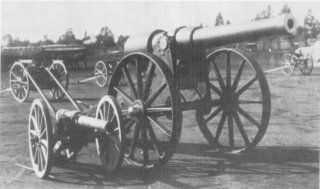
Its share in the defence of Kimberley completed, 'Long Cecil' was returned to the DFA gun park on 18 February with instructions that it was to be kept 'clean and serviceable'. An object of considerable interest to Gunners of the relief force, and to others who took the opportunity to see it, the gun was not again used in action during the war, but more fame lay ahead. On Friday, 9 August 1901, Maj T.J. May, CMG, Battery Sergeant-Major H. Wilkins, Sgts Wheaton and Lust, with a detachment of ten NCOs, Gunners and Drivers entrained with 'Long Cecil' for Cape Town where the gun was to be exhibited during the visit of Their Royal Highnesses The Duke and Duchess of Cornwall and York (later H.M. King George V and Queen Mary). The gun and a well-feted, and one suspects, exhausted detachment, returned to Kimberley on 29 August. Then, on 26 March 1902, Cecil Rhodes died and 'Long Cecil' went to Cape Town for the second time during the war, on this occasion to serve as the gun carriage in Rhodes's funeral procession to Cape Town railway station and again from Bulawayo station to his final resting place in the Matopo Hills. For this last journey 'Long Cecil' was pulled at first by mules and, for the final stage, by twelve gleaming black oxen. Thereafter the gun was returned to Kimberley to be placed on the Honoured Dead Siege Memorial where it stands to this day. In the Museum of Artillery in the Rotunda at Woolwich there is a good scale model of the gun, made, it is believed, by Mr Harry Beer who was one of the artisans employed in making the original gun during the siege.
Close by the Siege Memorial in Kimberley is a comparatively new suburb called Monument Heights and nearly all its streets are named after people who have played their part in the city's chequered history. Both Chamier and Kekewich have streets named after them and it is ironic that, with a changing population and the passage of time, few people in Kimberley today know who these men were or what they did. Labram is perhaps better remembered for, as Brian Roberts puts it in his recent book Kimberley: Turbulent City, 'Few men had done more for besieged Kimberley than George Labram; few men were more deeply mourned'. Today 'Long Cecil' remains as visible proof of his achievements. A suburb of Kimberley has been named after him but, other than an annuity to his widow and a grant for his son's education (both paid by the De Beers Company), this is the only recognition ever given him for his many contributions towards the successful defence of Kimberley. No acknowledgment of his services was made by the British Government, but what has been done by a grateful Kimberley is possibly more lasting and generous than a posthumous medal.
| Range Table : 4.1-inch Gun 'Long Cecil' Projectile : 2 crh Common or Ring Shell: 29 lb. Charge : 5 lb. 'Kidney' Powder Muzzle Velocity : 1710 fs |
|||
|---|---|---|---|
| Quadrant elevation | Time of flight | Remaining velocity | Range |
| ø | seconds | f/s | yards |
| 1 00 | 2.0 | 1334 | 1000 |
| 2 45 | 4.5 | 1070 | 2000 |
| 4 49 | 7.5 | 937 | 3000 |
| 7 27 | 10.9 | 838 | 4000 |
| 8 57 | 12.8 | 796 | 4500 |
| 11 63 | 14.6 | 760 | 5000 |
| 12 38 | 16.6 | 723 | 5500 |
| 14 56 | 18.7 | 689 | 6000 |
| 17 09 | 20.9 | 659 | 6500 |
| 19 42 | 23.2 | 630 | 7000 |
| 22 21 | 25.6 | 602 | 7500 |
| 26 16 | 28.1 | 577 | 8000 |
| Table of comparative data for 'Long Cecil' and equivalent British guns in service in 1899 |
|||
|---|---|---|---|
| Gun | BL 30-pr Mk I |
BL 4-in Mk IV |
Long Cecil |
| Weight of piece (nominal) kg | 1016 | 1320 | 1625 |
| projectile (filled) kg | 13.6 | 11.34 | 13.15 |
| charge (powder) kg | 1.13+ | 5.44* | 2.26 |
| Calibre mm | 101.6 | 101.6 | 104.14 |
| Length overall m | 2.92 | 3.04 | 3.04 |
| of rifling cm | 22.42 | 22.54 | 24.95 |
| Chamber capacity cc | 4096 | 6833 | 2785 |
| Muzzle velocity m/s | 503 | 579 | 521 |
| Remaining velocity at 900m m/s | 389 | 440 | 406 |
| Elevation (maximum) deg | + 16 | + 25 | + 26 |
| Range m | 5750 | 7050 | 7300 |
| Rifling | 24 PPS(mod); 1in 120 increasing to 1 in 30 |
24 PPS(mod); 1in 120 increasing to 1 in 30 |
32 PPS(mod); 1in 100 increasing to 1 in 32 |
Note 1. + = cordite charge only; 2. * = 3« lb (1.58 kg) cordite charge also used.
Footnotes
Acknowledgments and references
Return to Journal Index OR Society's Home page
South African Military History Society / scribe@samilitaryhistory.org